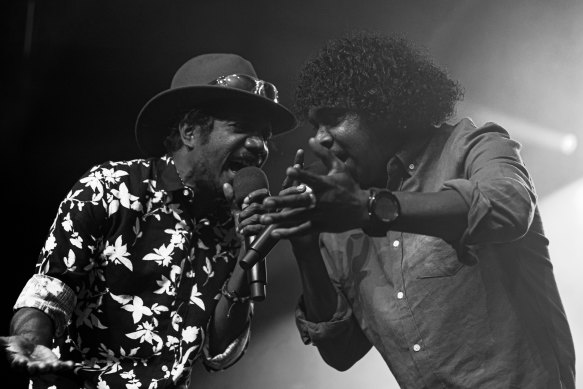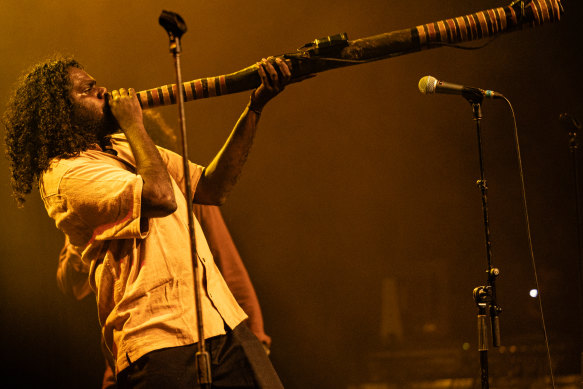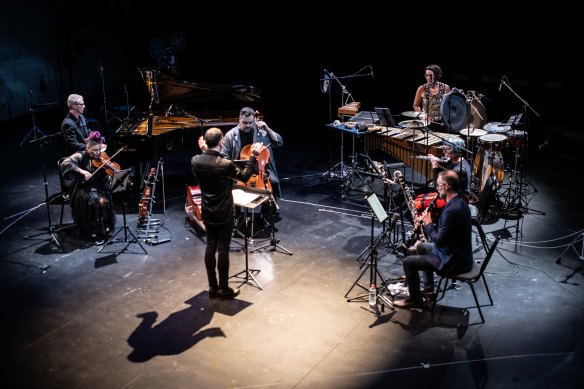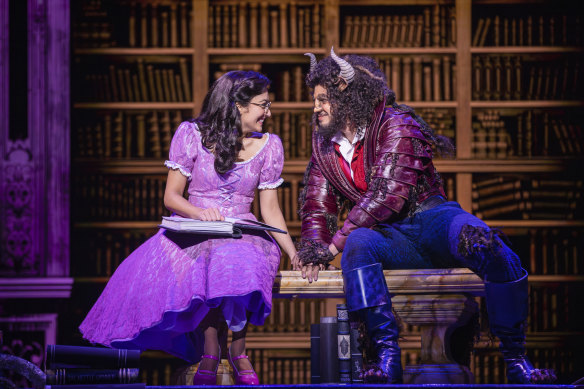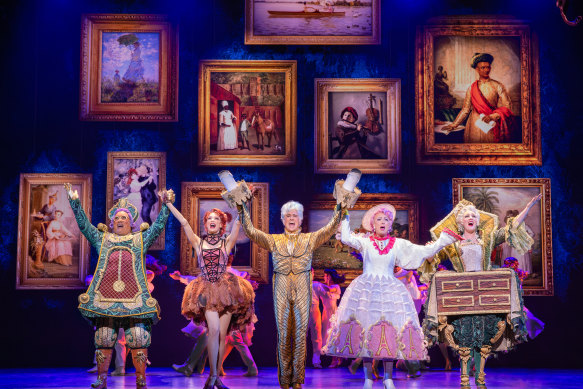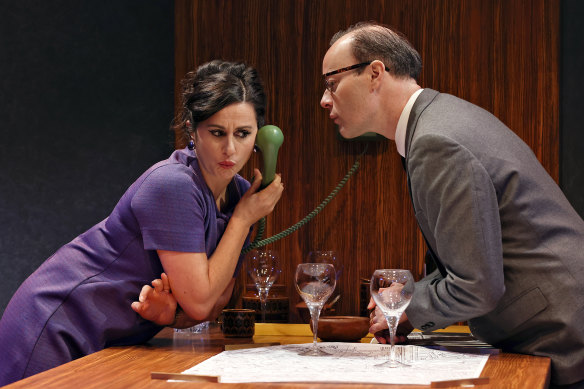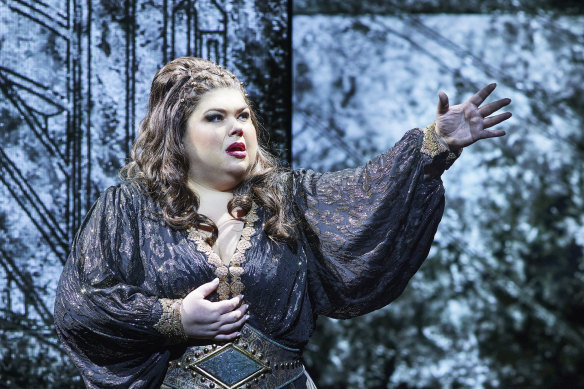This north-east Arnhem Land band has a fan in the prime minister
Save articles for later
Add articles to your saved list and come back to them any time.
MUSIC
King Stingray ★★★
Enmore Theatre, May 24
Despite seeing King Stingray perform at Parliament House last week, the prime minister was back for more at the first show of the surf-rock band’s national tour in Sydney.
Since releasing their debut single Hey Wanhaka in 2020, the band from north-east Arnhem Land has picked up fans across the country as well as the award for Breakthrough Artist at last year’s ARIA Awards.
King Stingray won hearts and minds at the first show of their national tour.Credit: Deb Pelser
On Saturday, King Stingray won hearts and minds when they shared the spotlight, not just with big names like Anthony Albanese, but with little kids aspiring to be like them.
“This is the future,” the band’s guitarist Roy Kellaway declared, ushering a trio of young kids onto the stage to sing fast-paced number Raypirri in Yolŋu Matha. There was a definite cuteness factor to it, but also a clear sense of brotherhood on stage among the performers as the band happily stepped into a support role for two of their songs.
The medley of elements, from classic rock instruments like the grungy electric guitar to clapsticks and didgeridoo, came together in an unexpected yet delightful way.
Perhaps combining these instruments comes naturally for the group. After all, last year they claimed one of the biggest songwriting prizes in the world for their hit Milkumana.
But their instrumental prowess was even more spectacular live. The didgeridoo, played by Yimila Gurruwiwi, drove the songs at the beginning of the set, before it began to blend in beautifully as the show progressed.
Yimila Gurruwiwi demonstrated his prowess on the didgeridoo.Credit: Deb Pelser
Among the highlights of the show was King Stingray’s cover of Coldplay’s international hit Yellow, which the band first performed for Triple J’s Like a Version last year. Lead singer Yirrŋa Yunupiŋu’s raspy tenor voice, complemented by Kellaway’s smooth backing vocals, lent the two-decade old song a soulfulness and complexity that made it arresting and poignant.
Yet the entire band played crucial roles throughout the show. Lewis Stiles’ drumming was clean, the harmonies were perfectly executed, and in songs like indie-rock number Let’s Go in particular, backing vocalists Campbell Messer and Dimathaya Burarrwanga’s more subtle voices brought a richness to the band’s unique sound.
While Kellaway said the band “felt a bit of pressure” having Albanese at their show, they won hearts with their humbleness and proved the band’s energy, innovation and musical prowess could bring everyone to their feet – even the prime minister.
Reviewed by Millie Muroi
MUSIC
Incredible Floridas ★★★★
Carriageworks, June 23
Richard Meale’s 1971 30-minute work Incredible Floridas was something of a coming-of-age piece for Australian music – or at least a particular strand of it.
In contrast to Peter Sculthorpe, who consciously turned away from the Western tradition, Meale’s work, written for Peter Maxwell Davies’ ensemble Fires of London, boldly walks into the pantheon of European modernist music, speaks its language, drops a few sophisticated allusions and says something original.
Benjamin Kopp, Veronique Serret, conductor Jack Symonds, Blair Harris, Claire Edwards, Lamorna Nightingale and Jason Noble of Ensemble OffspringCredit: Oliver Miller
Ensemble Offspring’s performance under conductor Jack Symonds was spiky and seductive, drawing out the piece’s variegated textures over its six movements with reverent care, while emphasising the work’s brittle brilliance.
Each movement gives a sonic impression of poems by the French Symbolist Arthur Rimbaud. Meale’s sound palette has a strong French influence, pointing, on the one hand, to the evanescent textures of Debussy, and, on the other, the diffuse atonal universe of Boulez.
Meale added percussion to the classic 20th-century instrumental combination established by Schoenberg’s Pierrot Lunaire, avoiding the denseness and heaviness of that work. Instead he created something which sits comfortably in the post-World War II avant-garde tradition, but with a free creative spirit that avoids some of that tradition’s dogmatic orthodoxies.
The other established work on the programme was For Marimba and Tape by one of Australia’s electronic music pioneers, Martin Wesley-Smith, who subsequently rewrote the tape part for another Australian innovation, the Fairlight computer synthesiser.
On Friday night, percussionist Claire Edwardes matched the live marimba part to the electronic track with confidence and panache as though leading the dance rather than following it.
The concert opened with the premiere of the imaginary line about which the body rotates, written to accompany Meale’s work by Sydney-based composer Josephine Macken.
In it, the instrumentalists were connected by cotton threads which were sometimes used by one player to create sounds on the instrument of another. It started with low chthonic sounds on cello and bass clarinet while a contrasting section focused on wispy high notes and harmonics.
The cotton threads alluded to the metaphor of a musical line shared from one player to another while at the same time pointing to fragmentation, distance and disconnection.
Hexis, for cello and percussion, by French composer Augustin Braud, also receiving its premiere, created tension through long-held notes evoking a sense of cosmic distance that occasionally erupted and attenuated like a distant exploding star.
Reviewed by Peter McCallum
MUSICAL THEATRE
Beauty and the Beast ★★★★
Capitol Theatre, until December 24
So you think you’ve seen some coups de theatre in your time? Think again. Beauty and the Beast dusts the eyes with implausible visual magic and theatrical sleight-of-hand that very effectively disguises the show’s imperfections. Even those dragged along by their insistent eight-year-old daughter – those who might grumble in advance about the puerile subject and chintzy Disney – will be amazed to find themselves enthralled by what happens when bursting imaginations, brilliant technicians and vast budgets collide.
Stanley A. Meyer’s scenic design is a wonder-world fully integrating old-fashioned backdrops, enchanting three-dimensional sets and startling projections. Ann Hould-Ward’s costumes are more than a match, with Belle’s sparkly yellow gown getting its own round of applause. But then this show was like a circus in terms of how often the audience started clapping, including a spontaneous standing ovation during Act One.
Shubshri Kandiah and Brendan Xavier star as Beauty and the Beast.Credit: Daniel Boud
The essence of the story, said to be thousands of years old, was distilled into the tale we recognise nearly 300 years ago. Several film versions predated Disney’s 1991 animated feature, before the same company hit Broadway in 1994 with this musical penned by Alan Menken (music), Howard Ashman and Tim Rice (lyrics), and Linda Woolverton (book). Directed and choreographed by Matt West, that production now returns to Sydney for the first time since 1996.
West’s witty, exuberant and even breathtaking choreography is supremely realised by a local cast that’s led by Shubshri Kandiah as Belle, the Beauty of the title. Three months ago Kandiah was Cinderella in Belvoir’s brilliant production of Sondheim’s Into the Woods, and the characters are not dissimilar: an ingenue with a heart of gold who’s much smarter than all those who would manipulate her.
Kandiah charms with her presence, the lightness of her acting and the quality of her voice – even if her singing brings us to one of the show’s aforementioned imperfections.
Menken’s score is an old-world Broadway melange with precursors stretching from the 1920s all the way through to the 1960s and A Funny Thing Happened on the Way to the Forum, but the songs fall into two camps: the dazzlingly engaging comic numbers and the rest. Alas, when Belle or the Beast (Brendan Xavier) must sing of their emotions, all the playfulness and nuance seems to fly out the latticed window, leaving much heaving of bosoms, hitting of high notes and swelling of orchestrations, but with all the sound and fury signifying very little.
Xavier acquits himself well, although it’s a role that’s somewhat thankless. For most of the show his Beast is sulking, hulking, thick, wrathful and monosyllabic, and the character would hardly have lost the eight-year-olds in the audience had he been drawn with a smidge more complexity.
By contrast, the fullness of the minor characters is a strength, led by Gaston, the posturing village strongman (who thinks Belle is rightfully his just because he desires her), amusingly played by Jackson Head. Sustaining the laughs are Rohan Browne as Lumiere, Gareth Jacobs as Cogsworth, Jayde Westaby as Mrs Potts, Hayley Martin as Babette and the rest of the substantial cast. The ensemble work is flawless, as is the surround-sound and the orchestra directed by Luke Hunter.
The musical features an impressive supporting cast, who almost steal the show.Credit: Daniel Boud
The story’s enduring appeal and pertinence is that the Beast’s “otherness” ultimately does not prevent Belle falling for him. Belle, meanwhile, has all the snowflake purity of the fairytale, while also being sharp, brave and in complete command of her destiny – not a bad role model for those enraptured eight-year-olds.
Reviewed by John Shand
THEATRE
Benefactors ★★★½
Ensemble Theatre, until July 22
Up-and-coming architect David is tasked with transforming an inner-city slum into a modern housing scheme but, as the project makes its way through the grinding machinations of local government, his hopes to create a better way to live fall foul of cost-cutting and stakeholder demands. What’s new?
Benefactors is a dazzling puzzle of a play. Not in its subject matter: that’s as old as time and playwriting. Michael Frayn’s four-hander, written in 1984 and awarded Olivier and New York Drama Critics’ Circle Awards, is ultimately about human nature and dreams, and how dreams often end up circling the plughole. The real puzzle comes in the way Frayn unravels the story, backwards and forwards in time, in and out of memories, pieced together in vivid episodes heightened by the 20:20 lens of hindsight.
Emma Palmer and Gareth Davies star as Jane and David in Benefactors.Credit: Prudence Upton
It’s a brave – some might even say foolhardy – choice by Ensemble artistic director Mark Kilmurry. But his cast is all in, totally committed to the densely packed language and the deeply English turn of phrase, making Frayn’s heightened, byzantine dialogue seem almost natural. On opening night the laughs come in abrupt, unpredictable and sometimes inexplicable waves, with some of the darkest humour passing by unremarked.
The lynch-pin in a strong cast is Emma Palmer, brilliant as capable Jane, the one who makes the dinners, pours the drinks and remembers how it all unravelled with steadfast acuity. Gareth Davies, as David, dances the delicate dance of a man losing his integrity, piece by painful piece, and Matt Minto, as Colin, is a diligent wrecker on the side of chaos, wherever that might be. As for his wife Sheila (Megan Drury), she undergoes the biggest transformation, from naive ineptitude to surprised competence.
The production, designed by Nick Fry, centres on a kitchen worktop, on which the plans for David’s inner-city transformation are rolled out, scratched out, torn up; and on which endless cups of coffee and glasses of wine are poured.
Curiously, Kilkenny leaves the company to mime the pouring and drinking, and even the unceremonious throwing of a dish of stew, hot enough to send Colin to seek medical help. The miming goes on until the last scene, where David and Jane pour a glass of all too red wine and, suddenly, it’s real. We’re here. Benefactors is now.
Reviewed by Harriet Cunningham
OPERA
Aida ★★★★
Opera House Joan Sutherland Theatre, until July 21
Davide Livermore’s production of Verdi’s Aida, with sets by Gio Forma and digital design by D-Wok, replaces the triumphal pageantry traditionally accompanying this work with hyperreal digital images that appear and dissolve on mobile screens like scenes in a fantasy video.
Metallic snakes slither, blood-red clouds swirl and lightning flashes over moonlit water. Savage beasts, Egyptian figures in profile and a naked goddess with a swelling belly look on, all possessed of a disturbing hypnotic stare. These digital images create their own tension, alongside the eternal, irreconcilable conflict of love and loyalty that Verdi develops with such mastery.
Leah Crocetto stars as Ethiopian princess Aida in this Opera Australia production.Credit: Keith Saunders
Leah Crocetto as Aida has a voice of enveloping power and warmth, sustaining the soliloquy of act one with colour and expressively moulded line, soaring magisterially over the chorus and orchestra in the triumphal march in act two.
Elena Gabouri, as her rival Amneris, has a voice of firmer edge, effective in moments of high drama. She sang her climactic scene with tragic force, maintaining strength both in clamouring high notes and in guttural tones in the low register.
As ill-fated hero Radames, Najmiddin Mavlyanov had the most naturally attractive voice of the cast, with nutty-brown richness and sinuous intensity that was not overdone so that it retained a fresh bloom.
By contrast, Warwick Fyfe, as Aida’s father, the defeated Ethiopian king Amonasro, bristled with energy and fierce defiance.
Roberto Scandiuzzi as the vengeful high priest Ramfis had a forceful textured sound, haughty and imposing. As the King, David Parkin sang with a leaner, penetrating tone.
The duets of this opera are crucial to the unfolding of the narrative’s central conflicts. Nurtured by subtly insistent flexibility of tempo from conductor Stuart Stratford, the various pairings between the three principals, Crocetto, Gabouri and Mavlyanov, sustained taut engagement through balance and strength of musical shape.
As well as the splendour of the victory scene in act two, with radiant trumpet choirs from the high galleries, the Opera Australia Orchestra under Stratford brought out the nuanced originality of the quieter moments of Verdi’s score.
The Opera Australia Chorus in turn swelled resonantly, laughed playfully and prayed reverently, always with glowing texture and high professionalism.
Much of the weight of the battle and victory is taken by a group of women dancers who, under Allie Graham’s choreography for this revival, combined grace with convulsiveness, agility and aggression.
Reviewed by Peter McCallum
Sydney Morning Herald subscribers can enjoy 2-for-1 tickets* to the Archibald, Wynne and Sulman Prizes exhibition at the Art Gallery of New South Wales during June 2023. Click here for more details.
Find out the next TV, streaming series and movies to add to your must-sees. Get The Watchlist delivered every Thursday.
Most Viewed in National
From our partners
Source: Read Full Article
